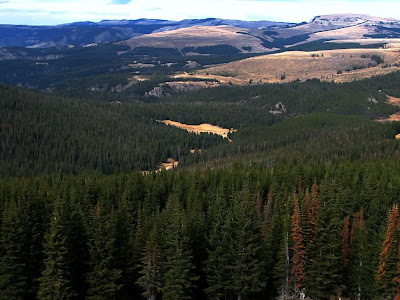(click pics to enlarge...2 are panoramas)
 Welcome to a very unique, sacred site known as "Medicine Wheel" in the Bighorn Mountains of north-central Wyoming. The site is clearly marked off of Highway 14-A in the northwestern ramparts of the Bighorns. Evidence suggests that this location has been in use for as long as 7,000 years... this roughly 80-foot circumference ancient site still serves as a gathering point for many sacred Native American ceremonies and rituals, with rock alignments also closely tied to major celestial events, as well.
Welcome to a very unique, sacred site known as "Medicine Wheel" in the Bighorn Mountains of north-central Wyoming. The site is clearly marked off of Highway 14-A in the northwestern ramparts of the Bighorns. Evidence suggests that this location has been in use for as long as 7,000 years... this roughly 80-foot circumference ancient site still serves as a gathering point for many sacred Native American ceremonies and rituals, with rock alignments also closely tied to major celestial events, as well.  Sitting on a high alpine plateau at an elevation of 9,642 feet, this site yields vistas of such areas as the Bighorn Basin, the Absaroka Range, the Wind River, and the Pryor Mountains. Given the geographic location, I can't imagine the fickleness of weather conditions at the Spring and Fall Equinoxes, or the Winer Solstice...but this "Circle" was quite active during it's time. A long time.
Sitting on a high alpine plateau at an elevation of 9,642 feet, this site yields vistas of such areas as the Bighorn Basin, the Absaroka Range, the Wind River, and the Pryor Mountains. Given the geographic location, I can't imagine the fickleness of weather conditions at the Spring and Fall Equinoxes, or the Winer Solstice...but this "Circle" was quite active during it's time. A long time.
 There are 28 spokes to the wheel...believed to be the (average) 28 days to a lunar cycle...two of the 6 cairns mark the horizons of sunrise and sunset...while the remaining four cairns mark the rising of the brightest stars...
There are 28 spokes to the wheel...believed to be the (average) 28 days to a lunar cycle...two of the 6 cairns mark the horizons of sunrise and sunset...while the remaining four cairns mark the rising of the brightest stars... It was not a location unique to an individual tribe; most feel it was an area of religious significance to more than 70 tribes, mostly Plains Tribes (especially Crow and Shoshone in recent history).
It was not a location unique to an individual tribe; most feel it was an area of religious significance to more than 70 tribes, mostly Plains Tribes (especially Crow and Shoshone in recent history).  It has a cultural and historic significance far beyond that of an observatory, though those elements clearly exist to this day. Of notable chiefs using this site was Chief Joseph, of the Nez Perce nation, who fasted at this site for his spiritual revelations. Clearly, such an indigenous and sacred site was worth immediate preservation, especially with the spike in tourism felt in the 1970s. 8-9 months out of the year, snow prohibits access, which puts tremendous pressures on the site in the summer months.
It has a cultural and historic significance far beyond that of an observatory, though those elements clearly exist to this day. Of notable chiefs using this site was Chief Joseph, of the Nez Perce nation, who fasted at this site for his spiritual revelations. Clearly, such an indigenous and sacred site was worth immediate preservation, especially with the spike in tourism felt in the 1970s. 8-9 months out of the year, snow prohibits access, which puts tremendous pressures on the site in the summer months.  Sadly, there has been a high turnover of USFS management personnel in that district over the past 20 years as a result of the on-going racism that flies in both directions there (including death threats to one supervisor); as well, there is the continued legal pressure from the logging industry, filing lawsuits against the USFS to open the area up for timber operations. To say the least, protection of the Medicine Wheel site has been, well...hare-raising.
Sadly, there has been a high turnover of USFS management personnel in that district over the past 20 years as a result of the on-going racism that flies in both directions there (including death threats to one supervisor); as well, there is the continued legal pressure from the logging industry, filing lawsuits against the USFS to open the area up for timber operations. To say the least, protection of the Medicine Wheel site has been, well...hare-raising.

2 comments:
Thanks Bob! Great pics and very informative!
Ironically, I LOVE the cloud formation in the first pic! Something going on with that ..... !
Suzy :)
That cloud formation looks to be in the family of 'lenticular' clouds. While most are ovoid around peaks, they can be linear in fashion; they look like cotton candy with their soft edges, and are created by high winds aloft over mountain peaks, in particular. The photo was taken in late September when the jet stream would have been quite active in that region of the country. I liked 'em, too!
Post a Comment